Ripley Entertainment Inc.'s Blog, page 296
January 9, 2019
The King Of Lizards Was Actually A Whale
Featured in Ripley's Believe It or Not!

Basilosaurus was a fearsome, sharp-toothed creature that lived 40-35 million years ago and could grow 50-60 feet long. Its name means “King Lizard.” Yet Basilosaurus wasn’t a lizard at all. It was a strange, predatory whale.
The first Basilosaurus ever found, B. cetoides, lived in a shallow sea in what is now Alabama. The skeleton is so long and slender that it looks almost like a snake, but with a short rib cage, front arms, and a tiny pelvis that didn’t attach to any vertebrae. At first, scientists thought it was some sort of aquatic reptile, like the ones that swam in the oceans at the time of the dinosaurs. However, the Eocene, when Basilosaurus lived, was long after the time of the dinosaurs and their aquatic relatives, when mammals ruled the earth. By studying the animal’s teeth, scientists found that it was actually one of those mammals.
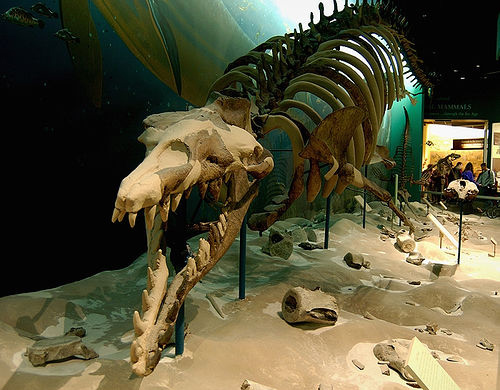
Basilosaurus skeleton at the Museum of nation History in Washington DC/CC Gini~
There’s still a lot that we don’t know about Basilosaurus, because some of its body parts weren’t preserved long enough for scientists to find them. Usually, nothing at all is left of an animal that’s been dead for millions of years. We know that Basilosaurus was the largest meat-eater of its time, and we know that it went extinct as the climate changed, but we don’t know what color it was. We don’t know much about its behavior. We may never know most of its features.
However, according to a study published in the journal PLoS One, we do know one more thing: Basilosaurus was (probably) an apex predator.
While most Basilosaurus bones have been found in Alabama, where the creature is the state fossil, there is a slightly smaller species of Basilosaurus found in Egypt. In 2010, paleontologists found fossils of hundreds of this species, B. isis, in Wadi al Hitan, a site 140 km southwest of Cairo. They also found fossils of a smaller whale called Dorudon atrox, crocodiles, snakes, fish, sharks, and relatives of sea cows.
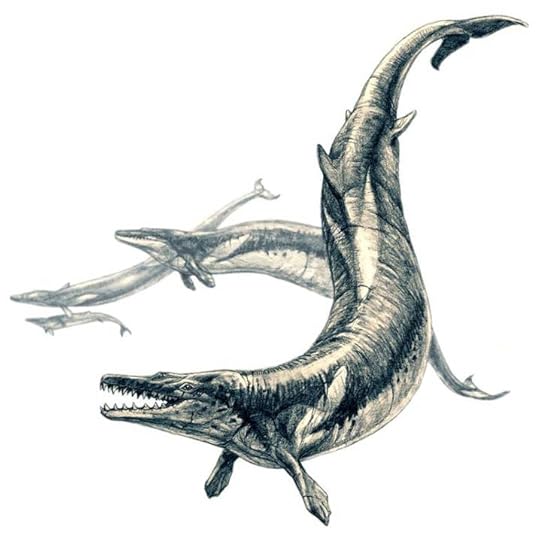
CC Riha Pavel
Researchers at the Museum für Naturkunde Berlin, Germany, analyzed these remains and made an important discovery about the animals that lived there, in “The Valley of the Whales.” One of the Basilosaurus skeletons found at the fossil site had the remains of baby Dorudons clustered where the Basilosaurus’s stomach once was, so paleontologists believe that Basilosaurus ate the smaller animal.
Still, they needed more than that to prove that it was a predator, and not a scavenger, who had simply found and eaten an animal that was already dead.
By examining the bones of the prey, the researchers found the evidence they were looking for. Many of the Dorudons had bite marks on their head. While it’s possible for scavengers to bite the heads of the dead animals they come across, it’s more common for predators to intentionally target the head of their prey, in order to kill them quickly.
Luckily, you don’t have to worry about running into the fearsome Basilosaurus when you’re out at sea–this creature went extinct 35 million years ago!
By Kristin Hugo, contributor for Ripleys.com
CARTOON 01-09-2019
January 8, 2019
The Crocodile Claw War Club Was A Fearsome Weapon
Featured in Ripley's Believe It or Not!

The Maori people of New Zealand migrated into the region from Polynesia in the 13th and 14th centuries. Canoes brought travelers and their customs to a new land. One tradition involved the taniwha, mythical sea creatures that followed in the forms of sharks and fish behind their boats. Each tribe was said to be held accountable by a taniwha. In some cases, the creatures acted as guardians, but in others, they could be malevolent deities.
As the Maori migration brought them closer to the continent of Australia, the mythology surrounding taniwha morphed. Maori people became familiar with caves and freshwater ponds. They also became familiar with the saltwater crocodile. While their neighbors to the west in Papua New Guinea had built an entire founding mythology on the crocodile, the Maori adapted them into their existing traditions.
As the legends changed, the taniwha began living in dark caves and assuming more lizard-like forms. Though it was rare for a Maori tribe member to encounter a saltwater crocodile, their appearance was inseparable from tales of the taniwha.

As flotillas of Maori settled New Zealand, occasional conflicts broke out between tribes. Though the Maori used spears for fishing, they used clubs for warfare. With no access to steel, these clubs were usually made of wood or whalebone, affording plenty of lethality in the hands of a well-trained warrior.
Though clubs were sometimes decorated with shark teeth, the pinnacle of warclub technology was called greenstone. These clubs were made from jade and belonged to only the most skilled and powerful warriors.

A Maori chief with a greenstone club.
The tribal powers established in ensuing conflicts produced a warrior culture that again caused the taniwha lore to change. Stories about wars with the taniwha became numerous and man always managed to outwit these ferocious beasts. In one story, a tribe managed to kill a taniwha together, and when they split open its stomach, they found villagers swallowed hole, along with greenstone clubs wielded by mighty warriors the beast had defeated.
The crocodile war club in the Ripley’s collection is the culmination of Maori traditions relating to crocodiles, the taniwha, and war clubs. Records indicate it was traded to the Maori from aboriginal Australians in the early 1800s before being made into a club. Perhaps a symbolic representation of wielding ultimate power, the club would likely have made a dangerous weapon, but was probably used in ceremonies and dances as a rattle instead.
CARTOON 01-08-2019
January 7, 2019
Journeys to Every Country in the World: Part 2 – Graham Hughes
Featured in Ripley's Believe It or Not!

INFORMATION
In a blog series, Ripleys.com spoke with travelers who have visited every country. Here’s what one traveler, Graham Hughes, experienced.
Sitting on a small minibus and traveling at full speed along a highway in Nigeria, Graham Hughes from Liverpool, England, practically feared for his life. It was 2009, and Hughes—surrounded by passengers filling every seat—was on his way to the city of Calabar from Lagos during his quest to visit every country in the world.
Out of his window, Hughes saw upcoming traffic jams resulting from a series of accidents, yet the minibus didn’t come to a halt. Instead, the driver steered the bus across the highway’s central reservation onto the other side of the road, battling oncoming traffic at 70 miles per hour. Other buses were doing the same thing. All the while, a Celine Dion soundtrack blasted at maximum volume on the stereo in the background. Hughes asked the driver to slow down—a surprising action for somebody attempting to break a world record!
“It was like something out of Mad Max,” Hughes says. “It was the maddest journey I’ve ever had.”
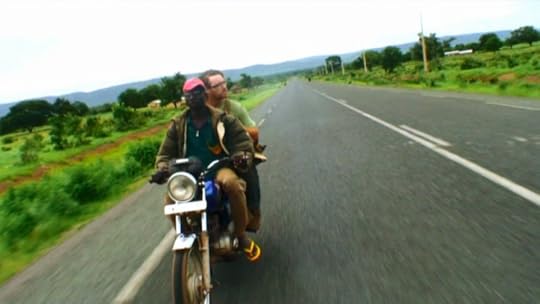
On the road in Niger.
This experience is one of the many Believe It or Not! moments Graham Hughes had during his four-year and one-month journey to visit all of the world’s countries—what he dubbed the Odyssey Expedition. And he traveled only using scheduled ground transportation. In total, he went to 193 United Nations member countries, plus Kosovo, Western Sahara, Taiwan, Vatican City, and Palestine. He counted the four nations of the U.K.—England, Scotland, Wales, and Northern Ireland—as four separate countries.
“I had to get around the world just on buses, trains, taxis, cargo ships, and the like,” he says—no planes, no helicopters, no driving himself, no hitchhiking. Hughes ultimately reached his goal, having spent on average about a week in each country. He did have to return to Russia in early 2013 to officially set the world record because he hadn’t gone through an official border post the first time around. Overall, he says, the length of his visits varied widely. For instance, he spent just a few minutes in Vatican City, Somalia, and North Korea.
During the first year of the trip, Hughes recorded many of his adventures on camera, and the compilation of that year was broadcast on National Geographic around the world and the Travel Channel in the U.S. Hughes was also featured in the 2015 edition of Ripley’s annual Reality Shock! and has since published a book, Man of the World, about his experiences, with more in the works. Here’s his story.
Plotting a Complex Journey
Upon starting his trip, Hughes set a goal: to raise money for the charity WaterAid. He also wanted to prove that traveling to every country could be done without flying. And maybe, he thought, his experiences would help illustrate that the world isn’t such a bad place after all. The whole trip cost him about $40,000, but he luckily saved up some money, including from when he was paid to create the show about his travels. Hughes found additional support from family members and friends.
He had to adhere to specific guidelines to break the world record. First off, he needed to enter each country legally and at an official border post—he couldn’t wade across a river or sneak across the street. Hughes also had to prove he had been to every country with a passport stamp or a photograph of him standing next to a country’s welcome sign. He was required to step foot on dry land—being in territorial waters alone didn’t count. These guidelines presented unique challenges.

The expedition started in Uruguay in South America. He decided to save the Pacific Island countries for closer to the end. Without access to air travel, Hughes had to travel to several island countries by cargo ship, and knew that part would be challenging.
“When I went into my plan, it was very, very detailed up to that point, and then it kind of got a little bit fuzzy because trying to travel around the Pacific Ocean…without flying is one hell of a challenge,” Hughes says. Hughes finished the main part of his journey in South Sudan, which hadn’t yet been a country when the expedition began four years earlier.
Aside from when taking cargo ships, Hughes devised unique ways to travel to and enter certain countries. When it came to North Korea, he says, he had two options: enter on the Young Pioneers tour via Beijing, or travel to South Korea and go to the Demilitarized Zone between the two countries. The area, Hughes says, has huts accessible to tourists that are half in North Korea and half in South Korea, with a table connecting the two across the border. He was allowed to walk around the table, Hughes says.
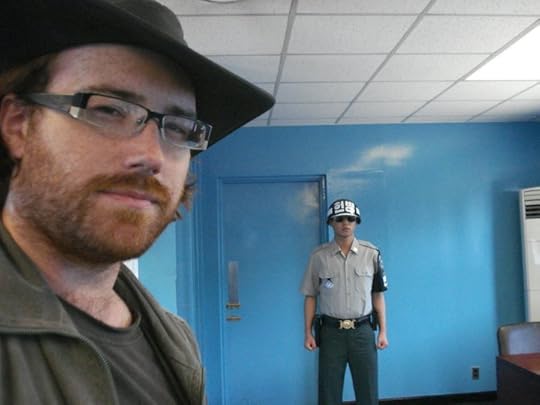
In North Korea.
For Hughes overall, careful planning and common sense were key to staying safe.
“Obviously I did my research before I started this, and I wasn’t going to be just wandering into a war zone with my backpack,” Hughes says. He chose to visit the safer areas of war-torn countries such as Iraq, Afghanistan, and Somalia, for example. But situations could change quickly and unexpectedly. While he narrowly avoided being in the Middle East during the Arab Spring—a wave of protests and demonstrations that began in 2010—he was in Nigeria at the same time a massacre broke out in the northeast part of the country, which marked the rise of the Boko Haram, a militant Islamist group. In that situation, he altered his route.
Navigating the Waters
Hughes’ says his most difficult country to get to was Seychelles, an archipelago in the Indian Ocean. Seychelles is located in what Hughes describes as “slap-bang in the middle of the high-risk area for Somalia piracy.” At the time he was traveling, the pirate situation by Somalia was “really bad” in the Indian Ocean, Hughes says, and most cruise ships and yachts avoided the area. A number of times, he tried talking to captains on ships at ports in various cities. None would bring him on board in part because that would invalidate their anti-piracy insurance.
Hughes waited for months, and he eventually had a stroke of luck when he came across a cruise ship traveling from Europe to Australia for the winter season with stops in India, the Maldives, Seychelles, and Madagascar.
“I thought, if I can get onto that ship, then I can take two of the last three countries off my list,” he says. “And so that’s what I did.”
Believe it or not, Hughes spent months living on 12 full-size container ships, traveling to many island nations and across the Atlantic Ocean. His longest journey on a ship was 34 days, from Australia to the Republic of Nauru, an island country, with stops along the way, and back to Australia. In his interview with Ripleys.com, he laughed as he recalled just how slowly the cargo ships moved. “The maximum speed is about 20 miles per hour,” he says. He found it ironic just how much fuel these ships burned. One of his reasons for not flying, he says, had been the effect of air travel on the environment.

Aboard a tanker in the Pacific.
Moments of Anger, Moments of Fear
There were times during his expedition to every country in the world when Hughes was reasonably frightened about what he experienced. He says he was put in jail a few times in Africa—including once when he was traveling to the Cape Verde Islands, located to the west of the continent. He encountered 10 fishermen from Senegal and asked if they could help him get to his next destination via their 40-foot boat, Hughes says.
But their journey in Atlantic Ocean waters abruptly ended when they were all accused of “people smuggling,” Hughes says, and detained on the Cape Verde Islands due to a gap in communication about Hughes’ reasons for entering the country. The 11 of them were crowded in a tiny cell that could have been designed for a single occupant and had to sleep on the concrete floor. Six days later, the case was put before a judge, who let them go.
What was even scarier, Hughes says, was a few months later in Congo. Hughes says it was unclear why he was arrested—he hadn’t broken any laws, and his visa and other paperwork were all intact. Yet for some reason or another, he spent another six days sitting in a jail cell by himself—shirtless without pants, shoes, socks, or his glasses. While he was frightened to a certain degree, Hughes says he was angry more than anything else. Eventually, he was released after the British Embassy in the Democratic Republic of Congo intervened. His friends had gotten in touch with the British Embassy in Kinshasa on Hughes’ behalf after he tweeted for help using his cell phone, which hadn’t been confiscated by the police.
“Looking back, I think I should have been more scared at the time; that was a very scary situation,” he says. “I don’t think in the moment you think that way.”
This story illustrated how even in situations where the outcomes seemed uncertain, Hughes had loads of support from those who cared about him most. In his book, he thanks a long list of individuals—everybody from his parents and brothers to those who helped him during the expedition itself to the teams involved in the creation of his book and TV show.
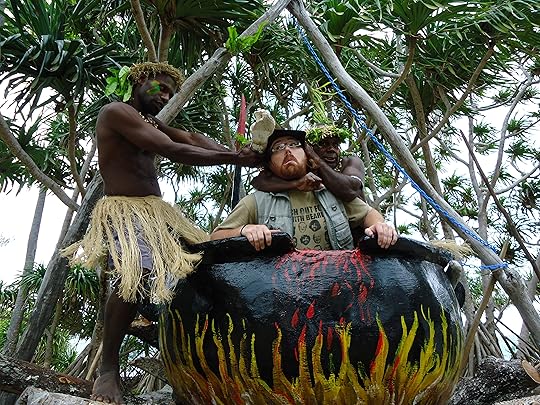
A more lighthearted “capture” in Vanuatu.
The Goodness of Humanity
In some cases, Hughes was surprised at the kind-heartedness of the folks he encountered. On a bus in Iran, traveling alone, he sat behind a Persian grandmother, likely in her 80s. She was speaking Farsi on her cell phone when she suddenly handed it to Hughes. Speaking on the other end was the elderly woman’s grandson, an English teacher in Iran. He told Hughes that his grandmother was concerned about him. The bus was scheduled to arrive very early—around 5 a.m.—and she feared Hughes would have nowhere to go and no one to make him breakfast, the grandson told him. The elderly woman wanted to ensure that Hughes was well fed. Hughes accepted her invitation.
“It was one of those moments where you just think, actually, the vast majority of people on this planet are all right. They really are,” he says, adding that “you really can’t judge people by their governments.” Hughes says he essentially wasn’t really treated with hostility anywhere; he didn’t get into fights, and he had nothing stolen from him. “I didn’t even get ill for the whole four years of the journey. So either I’m the luckiest person in the world, or the world’s not quite as bad as it’s often made out,” he says.
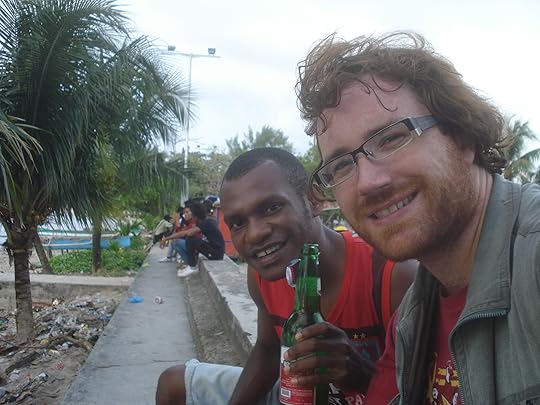
In West Papua.
Hughes says it’s difficult to say which country he visited is his favorite—after all, he did visit more than 200, based on how he counted. Along his journey, Hughes stayed with locals in completely unfamiliar places and witnessed aspects of cultures he didn’t expect. Of all the countries he went to, his most valuable lesson came from Iran, one of his favorite countries, which he described as hospitable, beautiful, and “surprisingly friendly.” The inquisitive, selfless nature of those he encountered there, he says, led him to pick up a mantra that sticks with him to this day: “Always be good to strangers,” Hughes says, “because one day you might be a stranger. And I think that’s a wonderful sort of philosophy in life.”
“Now,” Hughes recalls, “when I meet people from other places and other cultures and things like that, I’m a lot more open to wanting to hang out with them and find out where they’re from and what their life’s about, and what their dreams and aspirations are, than I was before I left.”
By Jordan Friedman, contributor for Ripleys.com
Source: Journeys to Every Country in the World: Part 2 – Graham Hughes
CARTOON 01-07-2019
January 6, 2019
CARTOON 01-06-2019
January 5, 2019
CARTOON 01-05-2019
January 4, 2019
There Is Now Life On The Far Side Of The Moon
Featured in Ripley's Believe It or Not!

[December 30, 2018-January 5, 2019] A double graduation, killer deal on diamonds, and finally there’s life on a celestial body besides Earth.
World’s Oldest… Fraud?
When Jeanne Calment died in 1997, the world believed her to be 122 years old. Research conducted by two researchers in France, however, question the validity of Calment’s claim. They purport that the woman who died in 1997 was actually Calment’s daughter, who had assumed her mother’s identity.

Buy One Get 47 Free
Dale Dickerson of Mississippi thought he’d surprise his wife with a diamond bracelet, but when the package he ordered arrived, it contained not just one, but 48 total diamond bracelets! In the spirit of the holidays, Dickerson decided to inform the company and send the extras back, a noble action rewarded by a complimentary pair of diamond earrings from the company, Jewelry Unlimited.

Finishing College At 16
Braxton Moral of Kansas was in the third grade when his teacher told his parents that he was “really, really gifted.” Braxton, proved his teacher’s words true and is now set to graduate at 16 years old. He’s not just getting his high school diploma, however. Just three days after he finishes high school, he’s on track to also pick up his undergraduate degree from Harvard!

Houston, We Have A Problem
Dutch Astronaut André Kuipers spooked mission control in Houston when he dialed 911 from the International Space Station. Instead of being a desperate call for help, Kuipers explained it was a simple mistake. According to officials, the mistake is pretty easy to make on the station’s space phone. Astronauts have to dial 9 for an outside line, followed by 011 for an international number.

Life On The Moon
On January 2nd, the Moon got some new life. China’s Chang’e-4 lander brought a tin of seeds and silkworms to the far side of the Moon. Chinese researchers loaded a biodome of rockcress and potatoes along with the worms in order to study whether lunar cultivation is possible. These are the first organisms to visit the Moon since the Apollo 17 mission in 1972.

CARTOON 01-04-2019
Ripley Entertainment Inc.'s Blog
- Ripley Entertainment Inc.'s profile
- 52 followers









